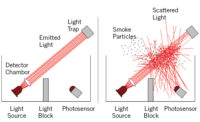Thinking Inside the Box
Offering reduced cost and ease of installation, bundled video kits are becoming attractive options.


Available in several configurations and offering a range of capabilities, video kits are designed to allow installers and integrators to meet the security and budgetary requirements of end users.
PHOTO COURTESY OF SPECO TECHNOLOGIES

A number of video surveillance partners, including Hanwha Techwin America, now offer complete video solutions in a kitted box.
PHOTO COURTESY OF HANWHA TECHWIN AMERICA



Whether consisting of products, services or a combination of both, we’ve come to expect bundles. Cable providers offer bundles of any combination of TV, Internet and phone services, complete with the equipment to make everything work. That kind of one-stop-shopping convenience is one of the big draws of bundling. On top of that, packaged products and/or services also save consumers money, which is an even bigger attraction.
In security, the do-it-yourself (DIY) market has taken this approach and run with it, offering end users complete security alarm and/or video surveillance systems that are preconfigured for use and ready to go right out of the box. Simply place the equipment where you want, follow a few simple instructions and voila — instant security. It’s no wonder then that these types of kits have proven quite popular with a certain segment of end users —mainly for residential use, although some systems can be applied in small business settings.
Evidence that the industry recognizes the strength of the DIY market can be seen in the recently introduced RSI DragonFly DIY Security System, a joint offering from Vadnais Heights, Minn.-based RSI Videofied (now part of Honeywell Security) and Port Chester, N.Y.-based Security Dealer Network that includes burglar alarms and video surveillance. End users can install the system themselves; but unlike traditional DIY offerings, these bundled kits are designed for dealers and integrators to offer to their customers along with video monitoring contracts. Dealers receive a portion of each monthly contract, allowing installers to participate in and generate recurring monthly revenue (RMR) from this growing market.
Not to be outdone, however, several manufacturers are also offering video kits for professionally installed systems. Primarily containing cameras, recorders and some sort of software (whether for setup, video management or both), these kits provide preconfigured solutions tailored to meet the needs of a variety of customers, while simplifying the installation and configuration processes for dealers and integrators. (For a more complete look at what may or may not be included in a typical video kit, see “What’s in a Bundle?” on this page.)
Bundle Advantages
There are many advantages of using video surveillance product kits. Kits streamline the camera and recorder selection and purchase process. They also can take the complexity out of system setup/configuration, because security technicians are dealing with compatible products.
“It’s a quick solution and package that fits most of the smaller and simpler installation environments, so there is no headache for dealers or end users to figure out what they should use,” says Elizabeth Cheng, support and operations director for Duarte, Calif.-based EverFocus.
Alex Goussev, product manager for Amityville, N.Y.-based Speco Technologies, agrees. “You can get all of your products packaged together and purchased all at once from the same manufacturer. There are also no issues in terms of compatibility,” he says.
For those who have been hesitant to jump into IP with both feet or who may not have a high level of confidence in their networking skills, the plug-and-play aspect of video kits can eliminate a major roadblock to profitability.
“Video kits make it as easy as an analog system and take away the previous concerns from setting up an IP camera only to have video not appear on the monitor until they searched for and programmed the MAC address and other programming,” says Tom Cook, vice president of sales, North America, for Ridgefield Park, N.J.-based Hanwha Techwin America (formerly Samsung Techwin America). “This scared many dealers into staying with analog.”
For end users, a major factor in choosing video kits is lower cost, which comes from the equipment itself and ease of installation.
“Kits are packaged to be less expensive, and the NVR is preset to support auto setup and has a built-in PoE, creating a very simple and cost-effective solution,” Cook describes.
Choosing a Solution
While bundled video kits offer significant convenience and ease, there are still quite a few things to think about, including the number and type of cameras needed, the size and type of recorder, expandability, video management software and more.
To meet the needs of the majority of end users who can get the most benefit from bundled solutions, manufacturers offer their video kits in multiple configurations, ranging from analog or entry-level versions consisting of lower-resolution cameras with limited functionality to kits containing eight or even 16 full-HD cameras that offer more advanced features.
For example, Speco Technologies offers 17 different kits in either IP or HD-TVI format. These kits are available with either four or eight dome or bullet-style cameras, along with either a 1 or 2 terabyte DVR or NVR. Some kits include cameras with IR capability for viewing in low-light situations or at night. To read more about several manufacturers’ range of offerings, see “Who Sells Kits?” on page 76.
The number of options may seem a bit overwhelming but can be easily narrowed down by a simple series of questions. Does the customer want IP or HD-TVI? How many cameras? What level of resolution do they need to achieve their surveillance goals? Will the cameras be installed indoors or outdoors (or both)? What types of lighting challenges exist at the scene? The answer to each will allows installers to eliminate video kits until they arrive at the best configuration. In the end, the answers to these questions may also make it obvious that a particular application actually calls for a more complex, custom-designed solution rather than a kit.
Potential Applications
Like any solution, video kits will not be a good fit for every end user. So who should installers and integrators be targeting when offering these products? As an answer to this question, Goussev suggests dealers and integrators start by looking at residential and business applications where a single camera type would be sufficient to meet the end user’s needs.
While small and medium-sized businesses are ideal applications for video kits, Cook says installers and integrators shouldn’t necessarily limit their use of video kits to that market alone. Even security companies with a nationwide presence or customer base may find that video kits are right for some of their end users.
“For a large, multiple-location end user or a dealer with a national rollout, the product and the installation are the same across all locations, so installation becomes simpler and the end user training and understanding is also the same across all locations,” Cook says.
When it comes to determining whether or not to choose a bundled kit for an application, Cook suggests installers and integrators loop their customers in on the decision-making process. “Customers should be aware of why they are buying a kit — and again, it comes down to simplicity and minimizing the overall installation cost,” he says.
Not only should customers have an easy time understanding why a video kit is a good solution, they are likely to embrace these solutions based on overall familiarity with bundled solutions available across many industries.
“Ultimately, the demand comes from users because they just need something simple and economical,” Cheng says.
What’s in a Bundle?
Whether IP, analog or a combination of both, nearly all video kits contain the same components bundled together in a single box to simplify installation and configuration. The common ingredients across most or all manufacturers’ video kits include:
- Cameras (two to 16 analog or IP cameras, ranging from 2 megapixels to 5 megapixels in indoor/outdoor dome, mini dome, wedge or bullet styles)
- Lens (standard, fisheye, IR-corrected, etc.)
- Recorder (four- , eight- or 16-channel NVR or DVR with 1 terabyte
- to 3 terabytes of storage)
- Setup wizard
- Video management software (most also offer mobile viewing capability)
Beyond these most common components, some providers include additional pieces designed to make installation and deployment even easier for installers and integrators.
“Multiple kits are available from many manufacturers, but not all have cables or a smart setup wizard,” says Tom Cook of Hanwha Techwin, which includes both in its bundled offerings.
Who Sells Kits?
There are a number of manufacturers that offer bundled video kits in a variety of configurations. Among them are:
EverFocus
Four IP kits in both analog IP and analog HD format. IP kits include an eight-channel plug-and-play NVR and either four bullet cameras or four ball cameras. Analog HD kits come with a four-channel DVR and four bullet or ball cameras. Complete information can be found at http://bit.ly/1OfsU61.
Hanwha Techwin America (formerly Samsung Techwin America)
Kits include one- , two- or three-terabyte NVRs and two to 16 dome and/or fisheye cameras ranging from 2 megapixels to 5 megapixels. Also included are necessary cables and a setup wizard. Learn more at www.hanwhatechwinamerica.com/en/products/ip-kits.aspx.
Honeywell
Kits offer the choice of a 1- or 2-terabyte embedded NVR with four 1080p IP ball or bullet cameras. More information is available at http://bit.ly/1WKImOl.
RSI Videofied (Part of Honeywell Security)
Specialty kit designed for law enforcement use only. For more information, visit www.videofied.com/us/en/products/#products-kits.
Additionally, RSI and Security Dealer Network offer RSI DragonFly DIY Security System, a customer-installed, professionally monitored video security system. Full details are available at www.sdndragonfly.com.
Speco Technologies
Speco offers kits available in either IP or HD-TVI format. The wide range of kits consists of four or eight cameras (dome, mini dome and/or bullet) and 2-terabyte NVR or DVR. The company’s full line of video kits can be viewed at www.specotech.com/index.php/products/video/kits.
UTC Interlogix
Analog and IP kits with four or eight wedge or bullet cameras and DVR or NVR. For more information, visit www.interlogix.com/video/category/kits.
Looking for a reprint of this article?
From high-res PDFs to custom plaques, order your copy today!











